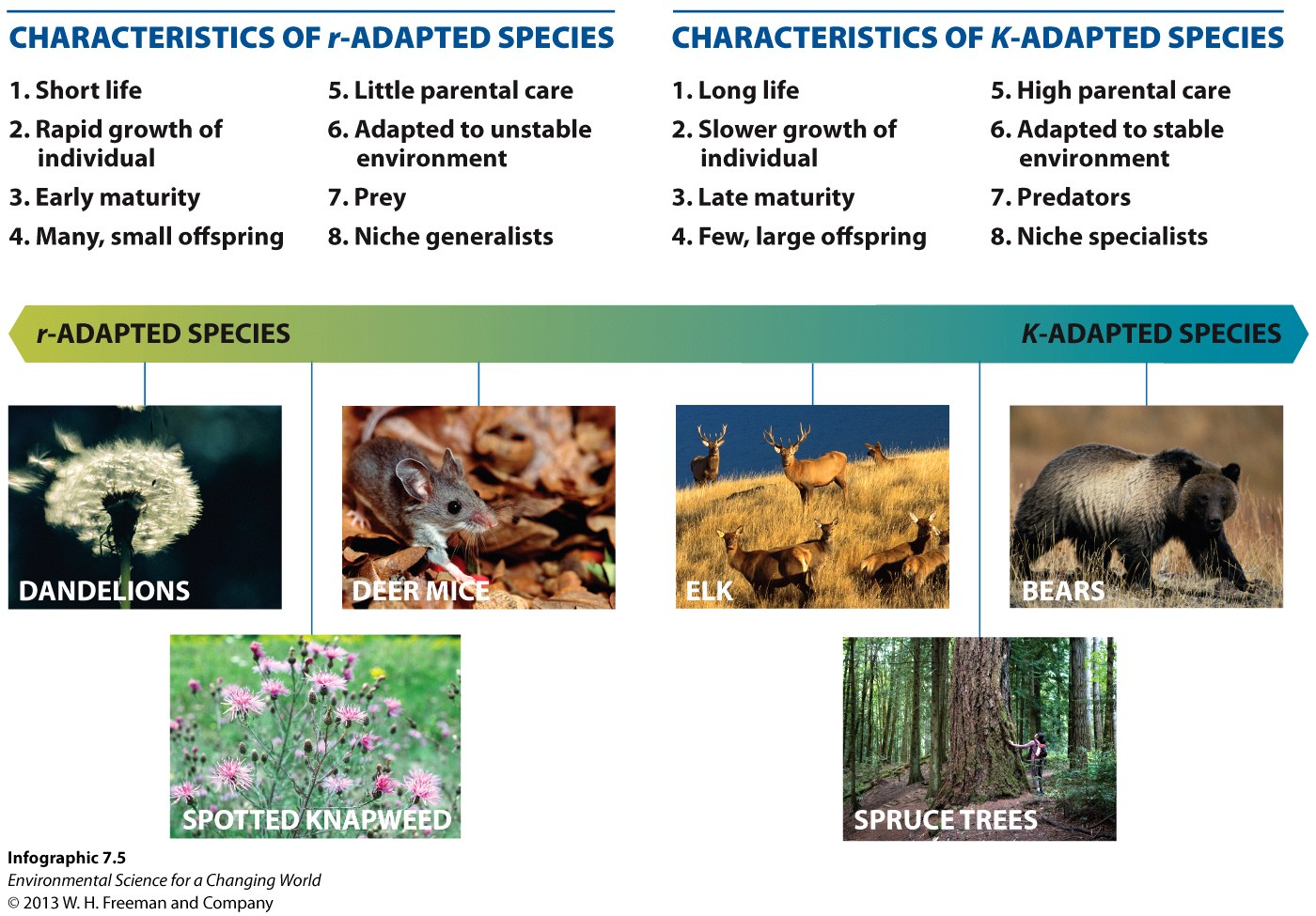Chapter 7. Chapter 7: Population Ecology
What are the reproductive strategies of r and K-adapted species...?

Guiding Question 7.3
What are the reproductive strategies of r- and K-adapted species, and how do these relate to population-growth patterns and potential?
Why You Should Care
Understanding how an organism divides up its resources between reproduction and maintaining itself helps scientists predict how a population of those organisms will grow, what role the organism likely plays in the ecosystem, and how likely populations of that organism are to crash in number. As an example, consider the classic pairing of a mouse and an elephant. Female elephants are pregnant for nearly two years before giving birth to (normally) one calf. They then care for that calf for 3 to 5 years before weaning and getting pregnant again. Elephant calves are born with few survival instincts and need to be taught by their mothers and relatives how to conduct themselves. Mice, on the other hand, take just 20 days to bear litters of around 10 pups, which are weaned and largely taking care of themselves in less than a month. Which species do you think is more likely to become threatened?
Question Test Your Vocabulary
Choose the correct term for each of the following definitions:
| Term | Definition |
|---|---|
| UNkoR/99cts+yyaoDZiZVqjf/cx5jkRGOfZ3n1BKQEQvMS8xCEWOKdqbUW4562RdFI72UjBWjKrz2iW/X5tJcGphs6YEvCxAZJqp/Svr7gpUrRfoFFGFIg== | Species that have a high biotic potential and that share other characteristics such as short life span, early maturity, and high fecundity. |
| axaUKwJ8OvgQwZOhCwX7upkzxYInd5BMybaQEoDUaLK691wKD2hQOehaicheTJQ5n9VE2gTmjfozU1whFLEhFSFaxFyBCg39JoPmKULIZ1dhRUzv4ZtIzQ== | How quickly a population can potentially increase, reflecting the biology of the species (life span, fecundity, maturity rate, etc.). |
| 1S2pV1XliER/gMx9l0r0f1vuvE20qAWZp1+3p5S8T0deSy3pb8kl8AfACn3CPLgd7DiVq7pHLuqz1WLp7TuSWu3Xsv190yWfH+1CNDqcbwT3Jxs0PcpDWw== | Species that have a low biotic potential, share characteristics such as long life span, late maturity, and low fecundity, and that generally show logistic population growth. |

Question 7.1
K0HZGcLGAnzH2IUjibwjiFdO7cl/vVSETF+pISuQpi2UTWZMZ50J91mopqOdqneUU9bwfQIYgoiTAvKpiHxh39vuICc3QmZN3YbV4X+xOpTbhwA1otHAzmH9RijsuiK+efsj9TlBNgthEN2wSulem2FwpcE+XZpYDuZxF4X+NHbi2KoNeDIYteZAGMZWgYFQ/B0DxJS37dQ=Question 7.2
JMta7FSk2cYg8ZqOcdIKyoR5eR+7rA7nGb0zRQYlNXzW2RDhukXp95gYyOZg6nLRikgTt/5gqSPW8Q/q8sfz2nV7ZY3hXJyUPnB+dxKpHQOJwMTIoDfpCsG5ZT40ejNazUFmeMclVvk/w37xzRqRSjkthvNAoeaFnC35pGincze3ONXKGrjHgZfxLDAyL/RZqPCuQHeE5I6ERq4iuSPfiOWa5/xBr/LaXhjXK10g/zj9dBt5pEPJj0VnqqcP6sbZ5RCDdYHHPXO3aLcUnFT0LzwNxaNO+JIWWA5ih1ZH0XsPaG2u8o30l1FcLk5u788xBGLnbat3t7dSHR04RfYjSMQXzKwXekX0nC57NsEOXCtYlAN4GkKKj2P7jhyGJi1LV5KHb4BmhC32kTKUr+02HEcGftWr4kI9pxaiM1T2X+pc74RkjqYkEodAxrrXSqyFQuestion 7.3
YzalvTsxFjwJ17LYuBSbvHoMAjh78hbkgTpiETeb607/A5PBq2TzwDAFE+bmpBcJylFJq3H5QNgx5kthdiIeT+CuzXHQGEWTIgqN9RMem2/sITIM75BtRRS2/GIxFaSEhawFJAuZ4S9y4ndQ4+Gc17OIKdDUlDBy/10OZTL5BR//WM8jcy/gMbMoqt3C/NH2MJ+3I0R6uqo3UtGR+Ykbm5UmpLJe7JMHEFvuat3dc8dGP0W8jbK42K+zTowC9EPTxfiiJgRYmeQD0/t0+zRiC/K3SarT+7SpQuestion 7.4
zTFICd45egXdA52GILXElmJ2xHdRe+7/hBg3s6daJwNwwwIm+53s6RdcZ21Q7DW7LQIcaakIE5C9ENW2792rOq/gmPoIcljJc6C+QOMsPA3GCgDmY3iQYUgY/zA2nGBv9JpW+qytSLmUQoMwVaqXVCeNZoLZCVFmwf0OmVL2KTtjSaE7kWYVp/MSxp8nv/DeWyYPP+ZjrbRxbRtA/SxoIh7mk5/kDU9HxmNUbEl4TcenCt94mQQ6E+si6JuVwnGcOS64Yh4yCYt6fbeFtql1jlA6Tmzyy8IDma0moCWSV8Qnxx5fsM/kM7ECV4KXaoPMVChm1w==Consider the table below when answering the questions that follow:
| Features of typical r- and K-selected species | r-selected | K-selected |
|---|---|---|
| Life span | Short | Long |
| Body growth rate | Fast | Slow |
| Age at reproductive maturity | Early | Later |
| Number of offspring per reproduction event | Many | Few |
| Size of offspring relative to parent | Small | Large |
| Amount of parental care | Low–None | High |
| Adapted to unstable environments? | Yes | No |
| Often prey? | Yes | No |
| Niche specificity | No | Yes |
| Number of reproductive events in lifetime | One–Few | Few–Many |
Question 7.5
Are humans r- or K-selected? 6Bwvr9f59IohfVKeCYz1VIUTh2ijhwTdHyw1p3+MA1v1OMJoihzJwJH3Z2PdPQJo
Question 7.6
Thought Questions: Many species do not fit neatly into the r- and K-selected categories. For each organism below, give at least one reason that it could be considered an r-selected species and at least one reason that it could be considered a K-selected species.
/sWtOGvDJQWteGqRcKTfhA== ckiX7AaDti/iS0tCbxUm3UX1dpg=B) Sea turtles: r-characteristics include many small offspring with little parental care that are often prey. K-characteristics include long life span, slow body growth, older age at reproduction, and many reproductive events.